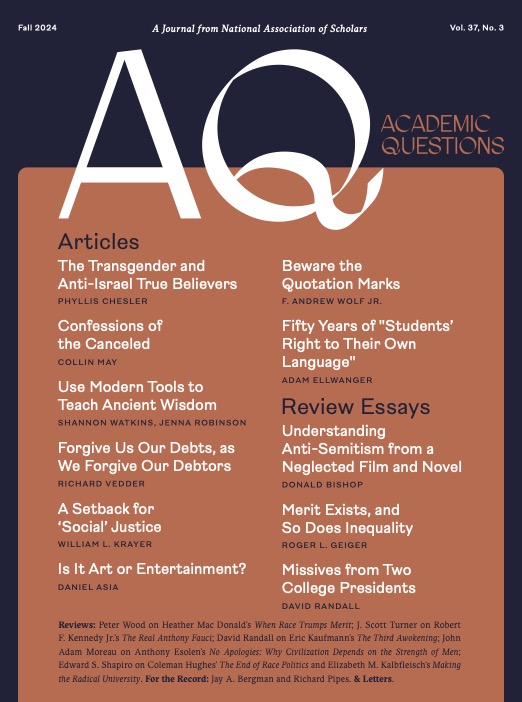I very much doubt President Joe Biden was thinking of the Lord’s Prayer when he proclaimed in 2023—and more fervently this year—his intent to forgive the debt of millions of former college students who had borrowed funds under the federal guaranteed student loan program. God was undoubtedly not on his mind, but rather the forthcoming presidential election. The timing of the move and presidential polls suggested he most likely was calculating that loan forgiveness would win him votes, especially those of younger Americans, in his ensuing election battle against Donald Trump.
Let me look at four dimensions of this issue: First, how has the federal student loan program evolved over time and has it been successful in achieving its objectives? Second, what are the arguments for and against loan forgiveness? Third, is it even legal or appropriate for the president to make such decisions himself by executive action? Fourth, are there alternative ways to deal with issues of collegiate access and high college costs that have more promise—and has little or no federal government involvement?
The Law of Unintended Consequences
Federal college student financial assistance begins with the Serviceman’s Readjustment Act of 1944 (the “GI Bill of Rights”), but loan programs began in a small way in the late 1950s and expanded with the Higher Education Act of 1965 (when they totaled about $1.6 billion in 2024 dollars). The loans were first targeted to lower income Americans or those pursuing high demand science disciplines but increasingly, from the late 1970s onward, they covered most potential college students. In reality, there are more than a dozen programs of federal student assistance, but in the interest of brevity and reader sanity I will concentrate on the major student loan initiatives that President Biden has targeted for forgiveness.
Loans under these programs have grown several hundred-fold since the Higher Education Act of 1965, even correcting for inflation, to well over one trillion dollars today. A large portion of the lending has been for loans to support graduate and professional education—law and medical school for example. By contrast, federal financial assistance generally has not been available for those with only a high school education attending short non-degree training programs in the trades and non-“professional” occupations: welding, computer coding, auto body repair, operating a small business, and so forth.
The federal student loan program is the best example I know of the Law of Unintended Consequences. First, the evidence is clear that, as Education Secretary Bill Bennett publicly opined in 1987, colleges started aggressively raising their fees, knowing that students and parents could borrow cheaply to pay them. This helped finance such pathologies as massive university administrative bloat. Additionally, and second, the programs utterly failed in achieving their initial primary goal of encouraging a larger proportion of college graduates from low-income backgrounds. Although the data are somewhat murky, it appears that the proportion of college graduates from the lowest quartile of family income recipients is at best the same as it was in 1970, and probably a bit lower.
Third, the massive enrollment expansion because of student loan programs contributed to deteriorating academic quality. Although our knowledge of overall learning and knowledge accumulation is scandalously scanty, many indicators suggest recent college graduates are no better prepared, and probably less so, than their counterparts of sixty years ago. And despite massive grade inflation (itself a cause of qualitative decline), data suggest that at least one-third of college entrants fail to graduate even in six years and at least one-third of recent graduates spend a meaningful period as “underemployed,” doing jobs that high school graduates usually fulfill.
Fourth, these programs have contributed meaningfully to woeful federal fiscal irresponsibility, as honest accounting suggests they add billions to a federal budget deficit that threatens Fiscal Armageddon if not corrected soon.
Fifth, these programs are constructed on a financially unsound basis—the terms of the loans are the same for all—regardless of the quality of the student and his/her academic performance, or the prospects for remunerative post-graduate employment. Computer scientists and accountants graduating from top private schools get the same terms as the gender studies graduate of the State College of Mediocrity. If private commercial lending standards applied, we would likely not have robust enrollments in such heavily politicized “woke” fields as gender studies—whose students often take post-college jobs as baristas.
Finally, although the evidence is not conclusive, it is probably not entirely coincidental that the sharp fall in American birth rates over time coincides with the explosive growth in student loans. College graduates, burdened with big debt and sometimes living in their parent’s basement, delay marriage and having kids, contributing to a birth dearth that will have big adverse effects in coming decades regarding caring for a rapidly aging population. Without the federal student loan program, savings for future college expenses would have been much greater, putting the U.S. on a better fiscal footing.
Loan Forgiveness: Economic and Political Perspectives
It is not seriously debated that the vigorous pursuit of student loan forgiveness is a move to increase the probability of the reelection first of President Joe Biden and now his successor Kamala Harris. The argument is that loan forgiveness will lead some otherwise negative or undecided voters with big loan debts to support Harris in the 2024 presidential election. Largely ignored in that political calculation, however, is the resentment felt by some non-college educated persons who have privately borrowed funds, not for college but other purposes (e.g. buying a business), not receiving the federal handout the college educated kids receive from loan forgiveness.
Many economists would say these forgiveness initiatives have created a major moral hazard and perverse incentives for future borrowers. The hard-working college engineering graduate who dutifully lived modestly after graduation in order to pay off $40,000 in student loans is treated shabbily relative to the general studies graduate whose $40,000 student loans have ballooned to $80,000 because of failure to make loan repayments, partly because she is “underemployed” and earning a modest wage working at Starbucks. Loan forgiveness incentivizes unproductive behavior—majoring in subjects that society does not value, and not making contractually agreed upon payments. Robbing the productive adherers to contractual obligations to encourage less productive behavior.
Does U.S. President Have the Power to Forgive Loans?
Of perhaps greater concern is the legality of it all. Already the U.S. Supreme Court has struck down the original Biden loan forgiveness package for forty-three million student borrowers (Biden v. Nebraska). Determined to proceed anyhow, the administration has decided to tie its forgiveness authority to a sentence in the Higher Education Act which could be construed to give the Department of Education discretionary authority to cancel loans. I am not a lawyer, and possibly the administration’s effort this time may have greater constitutional merit. Yet this amateur’s interpretation of the U.S. Constitution is that major questions of public policy need approval of the Congress, especially on budgetary matters. Judicial wrangling over this new forgiveness effort seems inevitable.
Alternatives to College Loans
Given the problems with subsidized federal loans, are there any realistic alternatives? Most students and their families do not have the minimal $100,000 needed to finance a typical four-year education leading to a bachelor’s degree. Even today with federal student loans, some individuals obtain loans on a commercial basis from banks or other lending institutions.
Two politically feasible ideas have gained some attention. One, perhaps the colleges themselves should have some “skin in the game.” The colleges admit and educate the students, so where there is a high loan default rate, it is sometimes at least partially the fault of the school that admitted them. Often, schools take academically marginal students in order to gain tuition revenues and perhaps some state subsidies. Why should the American taxpayer be saddled with the costs of the inappropriate acceptance of marginal students? If the colleges themselves were in effect co-signers on student loans—perhaps having to absorb one-third of the costs associated with loan defaults—fewer sketchy loans would be made and outstanding debts would be reduced.
A second idea is Income Share Agreements, whereby a private investor finances some of the cost of a student’s education but receives, in turn, a percentage of post-college earnings. This would provide a good measure of market perceptions of the value of a degree. A major in dance or Afro American studies might have to agree to pay the investor 25 percent of any postgraduate earnings over $15,000 a year for twenty years, while an electrical engineer might pay only 10 percent of earnings for only 10 years. Colleges could use some of their endowments to invest in their own students.
Broader efforts to increase collegiate efficiency and lower costs could also reduce the need for massive lending to students. For example, there is no reason that the amount of education currently taught students could not be condensed into three years—students rarely spend more than sixteen or so hours in class for only about thirty weeks a year—far less than students in the eighth grade. Why? If you can get a world-renowned bachelor’s degree at England’s Oxford University in three years, why not at Harvard, Duke, Northwestern, or Stanford?
Additionally, most colleges could significantly reduce costs without negatively affecting instructional capabilities. Non-teaching staff have exploded numerically in modern times—often referred to as administrative bloat. I suspect most schools could eliminate 20-25 percent of their non-instructional staff without imperiling the instructional function. Indeed, it might enhance it by showing that schools prioritize the dissemination of knowledge. Fine schools like Stanford or Michigan have more than 100 diversity, equity, and inclusion (DEI) related staff—probably eliminating all of them would improve the academic emphasis of school while reducing the ideological indoctrination inimical to the search for truth and beauty.
Bottom Line
Is American higher education in the post-1970 era of massive federal student loan provision qualitatively better than it was in an earlier period—say the 1950s or 1960s, before such loans existed or were rare? I think not, although the scanty empirical evidence is mixed. I think one could even argue that we have overexpanded higher education in this era, leading to qualitative academic decline and a lower occupational advantage for college graduates. Ending the federal loan programs in a non-disruptive fashion would likely take a number of years, but it is an idea whose time has come. It might cause a few colleges to close along the way, but I would argue a bit of creative destruction would be useful for the universities, as it has been for American business over the past two centuries.
Richard Vedder is Distinguished Professor of Economics at Ohio University, Senior Fellow at the Independent Institute, and a board member of the National Association of Scholars. He last appeared in AQ with a review essay, “Not Very Civic Education,” in the summer of 2020.
Photo by Alice Pasqual on Unsplash














